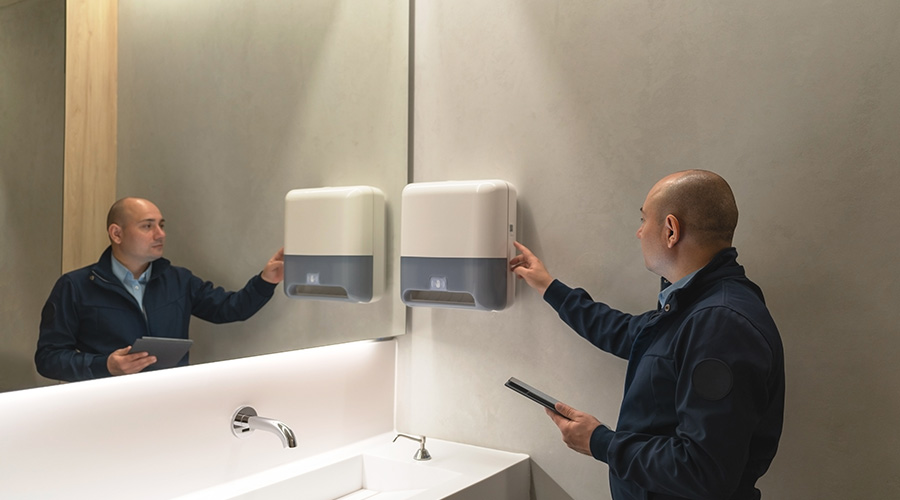Understanding Trends in Restroom Design
From artwork to robots, new strategies are improving restrooms both in terms of occupant experience and also reduced maintenance
Today’s restroom designs are nothing like the counterparts of yesteryear, where style took a backseat to functionality and where the maintenance of the space required constant attention. Advancements in technology and automation are making way for facility managers to incorporate some of the most innovative amenities available for restrooms in institutional and commercial facilities.
According to Rick Marencic, IIDA, design principal/studio leader, JCJ Architecture, new technology and upgraded products have led to an explosion in restroom design trends. A key area that is gaining momentum, especially in light of the recent pandemic, are touchless solutions.
“(Several manufacturers) have developed touchless solutions for faucet, dryer, and soap dispensers with trough-style sinks. Safety and appearance retention are primary goals of these combination-style units,” Marencic says. “Because hand washing and drying occur in the same space, water spillage on the floor is limited, mitigating slip and fall risks.”
In addition, deeper sinks can enable greater splash control. These are traditionally used in surgical suites, where water needs to be kept within the sink and off the floor, but they are proving useful in new locations.
“Many airports have installed combination style units,” Marencic says.
In addition to touchless restroom accoutrements, waterless urinals have also made inroads in the restroom environment. Resource conservation efforts and the popularity of touchless combination units have paralleled manufacturers' development of waterless urinals.
“With COVID-19, more customers and guests are keen on cleanliness and the spread of germs. Inevitably, the use of waterless urinals will grow with public awareness,” Marencic says. “Facilities managers are more familiar with the maintenance regimens; waterless urinals are ubiquitous at highway rest stops and are being utilized in stadiums.”
Tom Westerkamp, owner of Westerkamp Group, LLC, says that smart sensors that are being used throughout today’s restrooms also give life to the Internet of Things (IoT) with real-time feedback to the custodial team to alert them about product usage before it runs out, such as soap, antiseptic solutions, paper products, sanitary products, life of battery-operated devices, as well as water usage.
“Inline water meters measure flow, detect water waste and reduce costs. Locating these meters near restrooms will help identify waste source and reduce costs. Low-flow faucets and low flow toilets save water,” Westerkamp says. “While older toilet designs used three gallons per flush (gpf), newer designs use only 1.6 gpf. And the trend is to reduce water use further, as in waterless urinals.”
Design Innovations
In addition to state-of-the-art technology being used in today’s facility restrooms, art is increasingly being integrated into restroom environments. New printing technologies have enabled surfaces such as vinyl, metal, porcelain tiles, or glass to be printed with imagery.
“While this technology has been available for some time, the price is now more competitive due to the number of vendors offering the printing service, as well as the number of manufacturers incorporating the printing technology into the running product lines and custom programs,” Marencic says. For example, Tampa International Airport recently was named a finalist in “America’s Best Restroom” contest orchestrated by Cintas Corporation. The airport’s Airside C restrooms boast large graphics, as well as “cockpit” style facilities in which bathroom users have their own space with sensor-activated faucet and soap, trash bins, and personal paper towel dispenser – all within an arm’s reach.
Of course, durability is paramount in public restrooms. That’s why Marencic points to gauged porcelain now being used in facility restrooms. Gauged porcelain tile panels and slabs have become thinner, lighter, and stronger over the last 10 years.
“These panels can be used for floors, walls, and vanities and typically reproduce vein cut and large-scale marble and limestone slab patterns, producing a highly desirable level of visual quality without the cost and difficulty of marble slab installation,” Marencic says.
Panels can reach 12 feet, with thicknesses that range from 1/8 inch (3 mm) for wall applications to 3/4 inch (20 mm) for counter applications. Larger panel sizes translate into fewer grout joints and larger surface areas that are easier to clean.
“While patterns lend themselves to book-matching, installation remains a challenge that the industry is addressing. In many cases, specialized handling equipment is needed for moving the panels into place,” Marencic says. Large panels require specially designed cutting tools. ANSI A108.19 outlines specific installation instructions relative to the innovative products being introduced. As industry standards for installation are vetted and approved, the compelling beauty of large format porcelains is seductive and a first choice for many designers and architects.
Westerkamp says that stainless steel partitions also are still a favorite among many restroom designers. “Stainless steel partitions and fixtures last longer and are recycled, reducing the load on landfills and contributing to a better environment,” Westerkamp says.
And as employees begin the gradual process of returning to a workplace environment post-COVID, Westerkamp says they focus on such features as privacy, odor-free, clean, bright rooms, full dispensers, all fixtures working properly, and regular waste removal.
“Reluctance to return to the workplace may, in part, be associated with remembering how things were,” Westerkamp says. “Attention to these matters will be a way of saying management cares about health and well-being of occupants.”
Maura Keller is a freelance writer based in Plymouth, Minnesota.
Related Topics:













